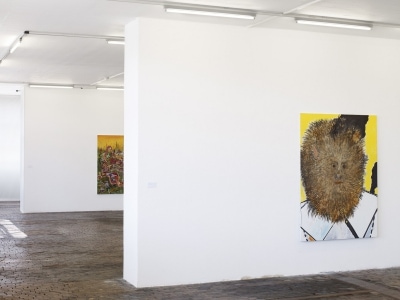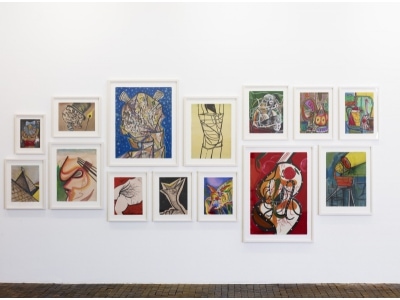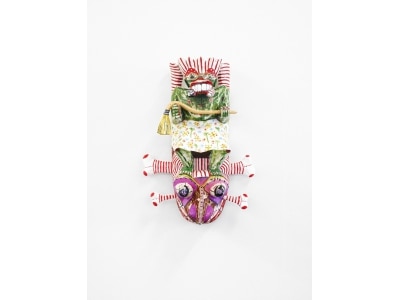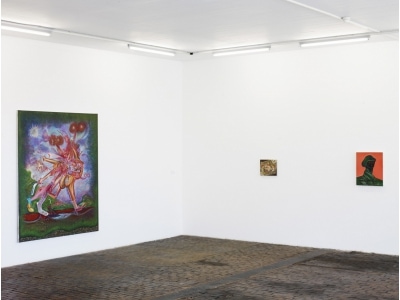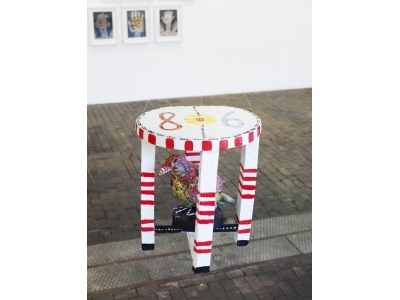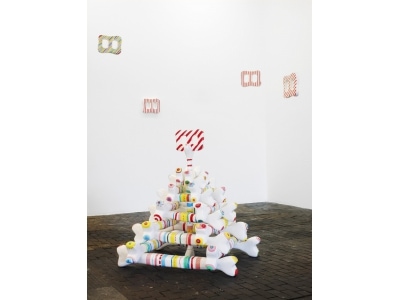
Jakub Julian Ziolkowski
Jakub Julian Ziolkowski’s work, presented for the first time in a Swiss institution, depicts a world rich with details and inhabited by emotions and obsessions. His canvases teem with motifs which generate a feeling of hallucinated multiplication. This Polish artist’s imaginative world is bursting with a chain of references – from modern abstraction’s geometry to Street Art, to Philip Guston, Hyeronimus Bosch and R. Crumb – and is inhabited by emotions and obsessions.
A CARNIVALESQUE REALISM
If a sense of urgency and vitality dominates Jakub Julian Ziolkowski’s work, the latter is not presented in an easily absorbable fashion. Ziolkowski’s configurations are not for those who seek an orderly visual digestion. Quite the contrary, the viewers of his œuvre are likely to be overwhelmed by his sheer productivity, and even more, by the gargantuan iconographic parameters he operates within.Ziolkowski’s practice is akin to a bestiary of life, every emotion is metamorphosed into a memorable form: animal, mineral, vegetable and galactic. The viewers are invited to confront this visual onslaught and make what they may from its sensual and grotesque cacophony. Yet, to define the artist’s work as a pulsating mass of impulsive chaos would mean to ignore the impact of his approach. For in its monumental sense of excess, lies a vision of the world of significance to contemporary cultural thought. His work engages with the dregs of an everyday gross reality and, as with the notion of the carnivalesque, it indicates a desire to de-reify the socio-cultural world; and to liberate the suppressed potentiality that lies within the sensuous, the bodily and the profane.Ziolkowski’s quirky, scatological materialism is illustrated through myriad guttural images. Digestive organs processing life are depicted in Oesophagus (2008). A monstrous heart pulsating is presented in Magic Hat (2007). And throughout the artist’s œuvre, the recurrent mockery of death is embodied by a host of skeletal figures, as in Hotel Supernova (2007) where a top-hatted skeleton regales a small crowd of cockroaches with his violin, whilst another frolics amongst cobwebs with its feet stuck in toilet pans.
THE BEAUTIFUL AND SICKENING ALTERITY OF LIFE
Without a doubt, Ziolkowski’s practice resolutely challenges the abstractions of idealist thought. In his œuvre we confront an alternative conceptual and sensory regime that privileges the somatic and the everyday, the difference, or alterity, through the bodily interwining of self and other. For example in Untitled (Journey), 2007-2008, the body is presented in a state of extreme; where limbs and organs of different genders jostle for position. Whilst its circular rhythm, and existential nature, might echo Leonardo Da Vinci’s “Ecce Homo”, the wheel of life Ziolkowski confronts us with is radically out of control, challenging an orderly vision of the world and humanity’s position within it. At the onset of each work the artist faces a void, the canvas becomes his personal desert against which to catapult the sometimes beautiful, sometimes sickening alterity of life. An artistic practice without final solutions, Ziolkowski’s œuvre affirms the very possibility of cultural difference and upholds a politics of impurity whose implications reach out well beyond the aesthetic realm.
Curated by Katya García-Antón
